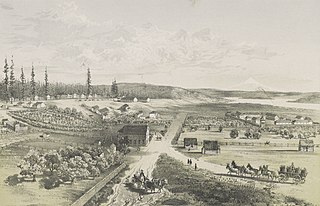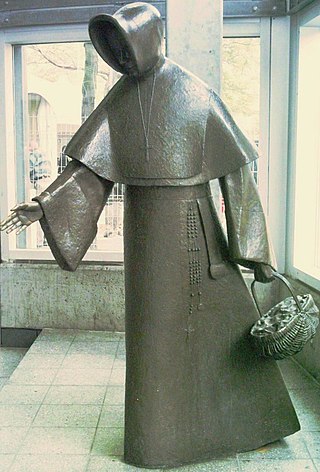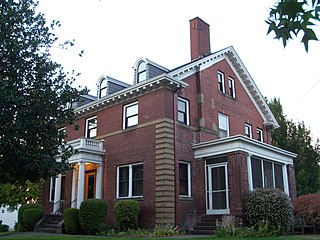
Fort Vancouver National Historic Site is a United States National Historic Site located in the states of Washington and Oregon. The National Historic Site consists of two units, one located on the site of Fort Vancouver in modern-day Vancouver, Washington; the other being the former residence of John McLoughlin in Oregon City, Oregon. The two sites were separately given national historic designation in the 1940s. The Fort Vancouver unit was designated a National Historic Site in 1961, and was combined with the McLoughlin House into a unit in 2003.

Ebey's Landing National Historical Reserve is a unit of the National Park Service on Whidbey Island in the Puget Sound, near Coupeville in Island County, Washington, United States.

The Sisters of Providence are a religious institute of Roman Catholic sisters founded in 1843 by Mother Émilie Gamelin. They are headquartered in Montreal, Quebec with five provinces: Mother Joseph Province, Holy Angels Province, Philippines Vice-Province, Émilie-Gamelin Province and Bernard Morin Province.

Fort Klamath was a military outpost near the western end of the Oregon Trail, between Crater Lake National Park and Upper Klamath Lake in Klamath County, Oregon, United States. The Fort Klamath Site, about a mile southeast of the present community of Fort Klamath, Oregon, is listed on the U.S. National Register of Historic Places
America's 11 Most Endangered Places or America's 11 Most Endangered Historic Places is a list of places in the United States that the National Trust for Historic Preservation considers the most endangered. It aims to inspire Americans to preserve examples of architectural and cultural heritage that could be "relegated to the dustbins of history" without intervention.
Tualatin Academy was a secondary school in the U.S. state of Oregon that eventually became Pacific University. Tualatin Academy also refers to the National Register of Historic Places-listed college building constructed in 1850 to house the academy, also known as Old College Hall. The building now serves as the Pacific University Museum, and is one of the oldest collegiate buildings in the western United States.

Mother Joseph of the Sacred Heart, S.P. was a Canadian religious sister who led a group of the members of her congregation to the Pacific Northwest of the United States. There, under her leadership, they established a network of schools and healthcare to service the American settlers in that new and remote part of the country. She was the first female architect in British Columbia. For her contributions to the development of that region, she was honored by the State of Washington as one of the two people allowed to represent it in the National Statuary Hall Collection in Washington, D.C.

Saint Joseph College and Mother Seton Shrine are two closely related campuses in Emmitsburg, Maryland, United States. It forms a historic district that was listed on the National Register of Historic Places in 1976.

Vancouver is a city on the north bank of the Columbia River in the U.S. state of Washington, located in Clark County. Incorporated in 1857, Vancouver has a population of 190,915 as of the 2020 census, making it the fourth-largest city in Washington state. Vancouver is the county seat of Clark County and forms part of the Portland-Vancouver metropolitan area, the 25th-largest metropolitan area in the United States. Originally established in 1825 around Fort Vancouver, a fur-trading outpost, the city is located on the Washington–Oregon border along the Columbia River, directly north of Portland, and is considered a suburb of the city along with its surrounding areas.

There are 75 properties listed on the National Register of Historic Places in Albany, New York, United States. Six are additionally designated as National Historic Landmarks (NHLs), the most of any city in the state after New York City. Another 14 are historic districts, for which 20 of the listings are also contributing properties. Two properties, both buildings, that had been listed in the past but have since been demolished have been delisted; one building that is also no longer extant remains listed.

The Covington House historic cabin in Vancouver, Washington, was built by Richard and Charlotte "Anna" Covington born, raised and married in London, England who travelled by ship around Cape Horn/South America, stopping at the Sandwich Islands/Hawaii and finally arriving at Fort Vancouver in the Oregon Territory, where they had been hired to teach children of the Hudson's Bay Company employees. The first three "plains" of the area were held by Hudson Bay Fur Trade Co. whereas the fourth "plain" was opened up for public sale as property north of the Columbia River became part of the United States, the government gave newly acquired land to early pioneers, willing to settle and farm the land. The Covingtons taught at the Fort immediately after their arrival, 1846 until 11 April 1848 when they entered "donation land claim" No. 43 640 acres (2.6 km2) in the Fourth Plain area, the community now referred to as Orchards, Wa, where they built their home, House No. 16 and Boarding School, per the 1850 census. Although they never had any of their own children, the couple established a boarding school in addition to operating a large fruit farm, called the Kalsus Farm. The children slept in the cabin loft, as it was an arduous seven – eight-mile trek, one way, north east of the Fort and wrought with danger for small children to attempt to travel alone. The Covington's log cabin soon became known as the social center of hospitality with musical entertainment in the early days of Vancouver on the Columbia River. Besides his guitar, they also brought a violin and the first piano to the Pacific Northwest as well, they also taught music to many of these local children at that time. Richard Covington was extremely talented, in addition to building their log cabin home, and developing an expansive orchard, he served in several offices as a justice of the peace, county clerk, school superintendent, cartographer, artist, musician, vocalist, and briefly as a ranger during an "Indian uprising" First Nations/Native Americans.

Corpus Christi Catholic Church is a parish of the Diocese of Sioux City. The church is located in Fort Dodge, Iowa, United States and is listed on the National Register of Historic Places.

The Hidden Houses are a pair of historic houses located in Vancouver, Washington. They are listed on the National Register of Historic Places.

The John P. and Mary Kiggins House is a 2.5-story craftsman style house located in Vancouver, Washington. The house was constructed in 1907 for John P. Kiggins, a Vancouver businessman and theater owner who served nine terms as mayor and sponsored many civic improvement projects. The architect and builder of the house are unknown, although Kiggins was trained as a building contractor and may have built the house himself.

The John Stanger House is a house located in Vancouver, Washington in the Jane Weber Evergreen Arboretum and is listed on the National Register of Historic Places. It is considered the oldest private home in Clark county still on its original site and the second oldest residence in the county.

Joseph William Royer (1873–1954) was a prolific architect from Urbana, Illinois who designed many prominent buildings in Urbana, Champaign, and beyond. His work included civic, educational, commercial, and residential buildings, many of which are listed in the National Register of Historic Places and feature a wide variety of architectural styles.

The Washington State School for the Blind, formerly known as the Washington School for the Blind, is a school for visually-impaired, blind, or deaf-blind students, located in Vancouver, Washington in the United States. The school building was added to the National Register of Historic Places in 1993.
Charles W. Slocum was a prominent American pioneer businessman active in the Pacific Northwest.




















